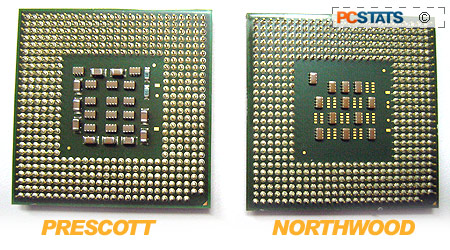The virtues of a smaller
manufacturing process and complex core logic are not all positive,
unfortunately. Prescott, even in its very first incarnation, dissipates a lot of
power. In fact, at 3.2GHz the core's Thermal Design Power (TDP), the target used
in determining thermal solution design, is rated at 103W. Motherboards based on
a previous voltage regulator specification may consequently have trouble
supporting the new processor.

Intel
claims that most motherboards will work fine with a BIOS update, which
third-party board vendors are expected to release. There's a chance that older
Socket 478 motherboards are simply incompatible, though.
How serious is the problem, you ask? We tested a total
of eight motherboards, randomly sampled from our test systems, for Prescott
compatibility. Of the eight, only three actually worked, including the D875PBZ
that Intel sent with the Prescott sample, ABIT's IC7-MAX3, and ABIT's AI7. Those boards that didn't work were
ASUS' P4C800-E, AOpen's AX4C Max, two of Intel's D865PERL, and an older D875PBZ.
Although the ABIT IC7-MAX3 and AI7 successfully booted into Windows, neither motherboard properly recognized Prescott’s clock multiplier, in both cases reverting back to 2.8GHz. Each board was flashed to the latest publicly available BIOS, but ABIT clearly has some work to do before touting full Prescott compatibility. Consequently, we weren’t able to overclock the Prescott core at 3.2GHz. The only remaining platform with which to test, Intel’s D875PBZ, is limited to a four percent “Burn-in” mode that doesn’t facilitate aggressive FSB manipulation.
Of
course, Intel can't comment on other manufacturers' boards, but it claims that a
BIOS update will not enable compatibility on older Intel boards that were
manufactured before the latest voltage regulator specification. Moreover,
there's no way to tell by looking at your motherboard if it can be made
compatible. If you purchased your Socket 478 motherboard within the past couple
months, you shouldn't have a problem upgrading.
Intel's
Prescott dissipates copious amounts of heat, but the good news is that the
3.2GHz model doesn't require any special treatment; the same retail heatsink and
fan combination that shipped with Northwood processors works fine. Given that
the heatsink uses the same physical socket and retention system, you can also
continue to use just about any after market cooler, like the Zalman CNPS7000A-Cu
for example.
Intel's
doesn't validate chassis designs, though, so you'll want to exercise caution
before coupling a Prescott processor and a small form-factor system.
What's in a Name?
The
launch of a new core with different features always introduces naming confusion.
Case in point: there are now four different versions of the 2.8GHz Pentium 4.
The standard Northwood-based 2.8GHz processor operates on a 533MHz bus, while
the 2.8C employs an 800MHz bus. The former doesn't support Hyper-Threading,
while the latter does. The 2.8A and 2.8E are both Prescott cores. Again, the
former doesn't support Hyper-Threading and runs on a 533MHz bus, while 2.8E is
Hyper-Threading enabled and 800MHz-ready. Undoubtedly, retail outlets are going
to have a hard time explaining the new model numbers to customers.
As a rule
of thumb, Prescott's are denoted with 'E' and 'A.' Northwood cores either don't
have a letter designation or are marked with a 'C,' if they are 800MHz and
Hyper-Threading-compatible.
 |
| PCStats Test System Specs: |
| computer hardware |
|
| processor: |
intel pentium 4 3.2ghz
prescott (800mhz)
intel pentium 4 3.2ghz
northwood (800mhz)
intel pentium 4 3.2ghz
extreme edition (800mhz)
amd athlon 64
fx-51
amd athlon 64 3400+
amd athlon 64 3200+ |
| motherboards: |
intel d875pbz 875p
asus sk8v k8t800
gigabyte k8vnxp k8t800 |
| videocard: |
nvidia geforce fx
5950 ultra 256mb (det. 53.03) |
| memory: |
corsair pc3500
cas2
corsair registered pc3200 cas2 |
| hard
drive: |
western digital
raptor 10,000rpm 37gb sata |
| cdrom: |
nec 52x cd-rom |
| powersupply: |
vantec 470w stealth
psu |
| software
setup |
windows xp professional with
sp1
directx 9.0b |
| workstation benchmarks |
pc magazine business
winstone 2004
pc magazine content creation
winstone 2004
futuremark pcmark04
futuremark 3dmark03 (v.340)
sisoft sandra 2004
x2:
the threat rolling demo
comanche 4 benchmark
test
unreal tournament 2003 demo
super pi
sciencemark
2.0
quake iii: arena v.1.32
povray
3.5 | |
